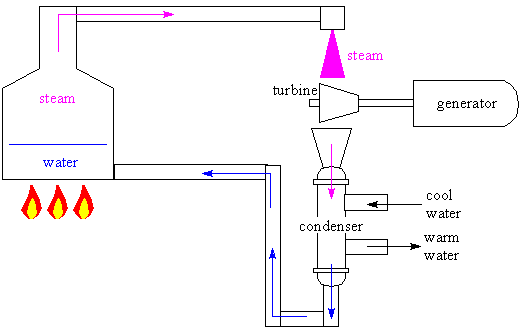IV. Heat engines and efficiency
A heat engine is a very simple idea. It is a device that converts heat into another form of energy.
Heat, microscopically, is particle motion -- atoms vibrating, molecules bouncing off each other, or electrons "sloshing around" in an electrical conductor. Matter normally expands when it is heated; this expansion can be used to do useful work. In thermoelectric devices, such as those used to power deep space probes, heat is converted directly into electric current.
Any device, such as a heat engine -- or a fuel cell, which converts chemical energy into electricity -- can be described by its efficiency: the amount of energy input that is actually converted to useful output. Efficiency is normally stated as a percentage:
| Efficiency = |
Energy out |
×100% |
|
| Energy in |
 In all heat engines, work is extracted from the flow of heat from a hot object to a cooler object, as shown schematically at right. A good example is an electrical power plant.
In all heat engines, work is extracted from the flow of heat from a hot object to a cooler object, as shown schematically at right. A good example is an electrical power plant.

In an electrical power plant,
- Heat from the fuel is used to boil water. Since the steam has much higher pressure than the original water, heat has been converted into mechanical energy (pressure).
- High-pressure steam is directed against a turbine, which turns a shaft: the pressure of the steam is converted into the rotational energy of the turbine and shaft.
- The shaft turns an electrical generator, converting rotational energy into electrical energy.
-
 Meanwhile, the steam is collected, cooled so that it condenses back to water, and pumped back into the boiler to be reheated. The heat from the boiler has been transferred to the cold water used in the condenser, and some of it has been extracted as useful work during the cycle.
Meanwhile, the steam is collected, cooled so that it condenses back to water, and pumped back into the boiler to be reheated. The heat from the boiler has been transferred to the cold water used in the condenser, and some of it has been extracted as useful work during the cycle.
Obviously there are going to be losses of energy during this process. The heat from the fuel may leak out into the environment instead of heating the boiler; heat from the steam may leak from the pipes due to imperfect insulation; the turbine bearings will lose some energy to friction, so that not all the rotational energy is transmitted to the generator; and a careful observer will notice that, because not all the heat has been extracted from the steam at the turbine, some energy is dumped into the cooling water. All real electrical power plants function at less than 100% efficiency; most operate at around 50%.
But this is practical, and in theory we could convert all the heat into electricity, right?
WRONG.
|